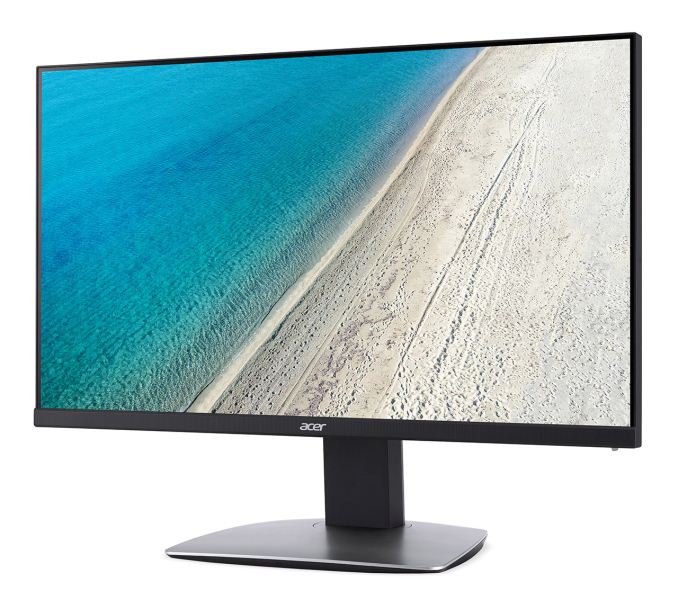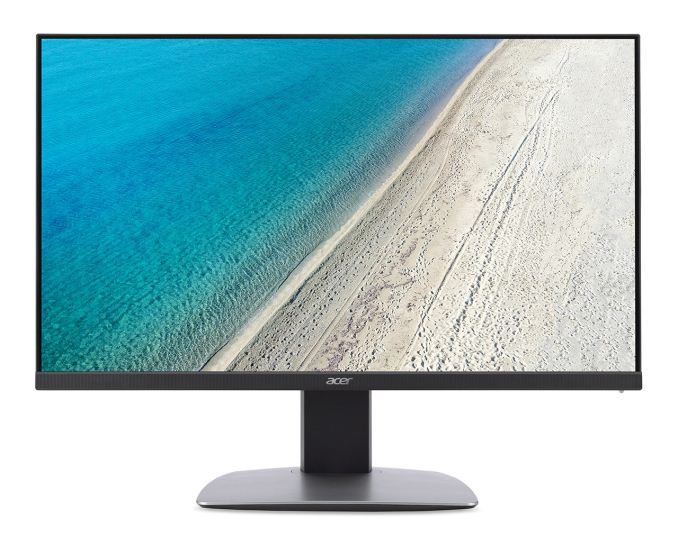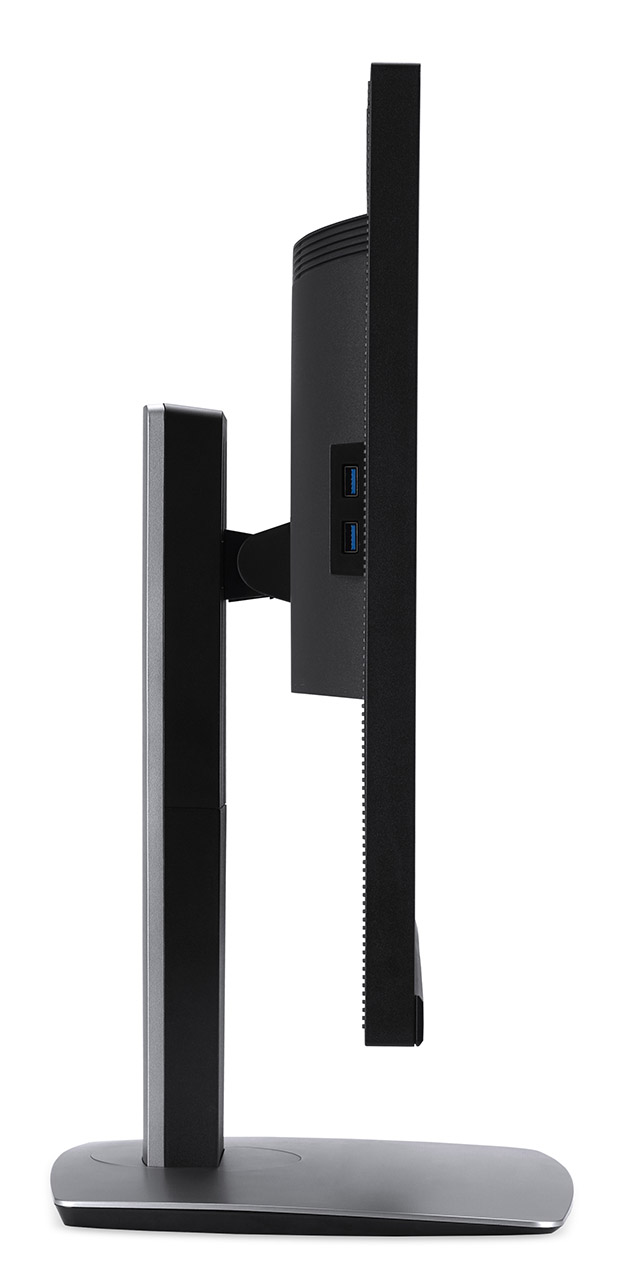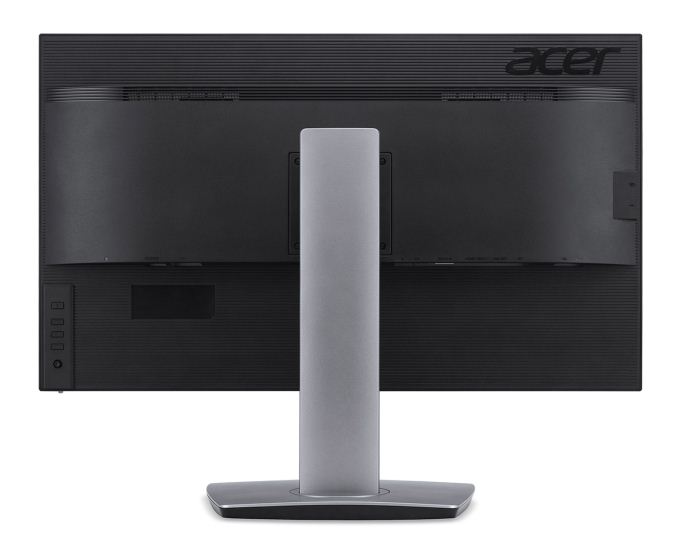Acer ProDesigner BM320 32-inch 4K Monitor Launched: dE < 1 Guaranteed
by Patrick MacMillan on May 8, 2017 2:30 PM EST- Posted in
- Monitors
- Acer
- Enterprise
- Professional
- Prodesigner
- BM320

While gaming monitors like the Predator X27 and Z271UV tend to get the most attention, there is still a significant market for work-oriented monitors that boast accurate color reproduction and a large work area. Those are two criteria that the new Acer ProDesigner BM320 has been designed to meet.
This 32-inch display has a native UHD resolution of 3840 x 2160 with a standard refresh rate of 60 Hz. It features an IPS panel with anti-glare coating, a peak brightness of 350 nits, wide viewing angles of 178°/178, and a 5ms response time. Contrast is listed as a comical marketing speak 100,000,000:1, which is the Acer Adaptive Contrast Management (ACM) figure.
Color reproduction and wide color gamut support is a key feature of this model, and it expands its range to include 100% of Adobe RGB, 100% of sRGB (plus 100% of Rec. 709), and 90% of DCI-P3 coverage. There is no explicit mention of a 10-bit panel, but support for 10-bit color is touted as a feature. The ProDesigner BM320 also comes factory calibrated and tested to ensure a DeltaE of 1.0 or less, which is near perfect color accuracy and better than almost all other claims of per-unit factory calibration, which typically gives dE < 3. Professionals will also have access to 6-axis color adjustment settings to create custom color profiles or simply to update the calibration as the monitor ages.
Given its professional positioning, the BM320 ships with Acer’s highly adjustable ErgoStand. The stand can tilt the display between -5 to 25 degrees, swivel +/- 45 degrees, pivot +/- 90 degrees, and provide height adjustments of up to 5.9 inches (150mm). The 90° of swivel rotation should not be overlooked since that means the display can be rotated into a vertical orientation. The ZeroFrame design results in this model having very thin screen bezels on three sides, which should help create near seamless multiple monitor setups.
| Acer ProDesigner BM320 | |
| Product Page | Link |
| Panel | 32-inch IPS |
| Native Resolution | 3840 x 2160 (16:9) |
| Maximum Refresh Rate | 60 Hz |
| Response Time | 5 ms (GTG) |
| Brightness | 350 nit |
| Contrast | '100,000,000:1' Using ACM |
| Viewing Angles | 178º/178º |
| Dynamic Refresh | None |
| Pixel Density | 138 PPI |
| Display Colors | 1.07 billion 10-bit Support 10-bit Native? |
| Color Gamut Support | Adobe RGB: 100% sRGB: 100% Rec. 709: 100% DCI-P3: 90% |
| Stand | Tilt (-5º to 25º) Swivel (-45º to 45º) Pivot (-90º to 90º) Height (up to 5.9-inch / 150 mm) |
| Inputs | 1 x DisplayPort 1.2a 1 x Mini DisplayPort 1 x DVI 1 x HDMI 2.0 |
| USB Hub | 4 x USB 3.0 (1 x USB 3.0 for hub) |
| Audio | 2 x 2W |
| Price / MSRP | $1299 |
Connectivity is listed as DVI, DisplayPort 1.2, Mini DisplayPort, and HDMI 2.0 video outputs. There is also a five port USB 3.0 hub (1 up, 4 down) and two integrated 2W stereo speakers.
The Acer ProDesigner BM320 is available now in the United States with an MSRP of $1299 and a three-year warranty. That is a high price tag for gaming enthusiasts, but not outside of the norm for a display aimed at creative professionals.
Related Reading
Source: Acer

















20 Comments
View All Comments
chaos215bar2 - Monday, May 8, 2017 - link
Err… split hairs. Let's not go around cutting bunnies in half.jack5150 - Monday, May 8, 2017 - link
wow, this looks like a dell ultrasharp clone, from the looks down to the lofty price.chrnochime - Tuesday, May 9, 2017 - link
Lofty price ha! This is nothing for the pro market.And compared to any run of the mill half decent road bike without any custom parts this is nothing either.
BrokenCrayons - Wednesday, May 10, 2017 - link
I'm not sure I understand the value in comparing the price of a computer monitor to a motorcycle.JanW1 - Monday, May 8, 2017 - link
Since when do Monitors have video outputs? Did someone proofread this?vladx - Monday, May 8, 2017 - link
Wow that's a pretty low price for a 4k creative display.avfx - Tuesday, May 9, 2017 - link
I've been reading this site over 15 years and just now registered because these image quality matters have bothered me for a long time. I see there's finally some progress being made but I'd like that progress to extend to the journalism and specs quoted as well."Color reproduction a key feature"... Correction: It's been a key feature since CGA CRT's if not since color TV's.
"178 viewing angles" So if TFT/IPS have 178 viewing angles, what sort of viewing angles do CRT's have? 17800 degrees? I just bought an Acer laptop with IPS and took photos of it and the photos don't tell the whole story, the entire screen looks completely black with a bit of sunlight coming on the side and even in pitch black room, while colors are less affected than in a cheap TN display, there's quite rapid drop in contrast/brightness and general readability of text if you're more than 15 degrees off the center.
So yes, there may be manufacturer saying "here's how we measured and did the math to get 178" but the "key" issue is that the measurement need to be the same across the board and cater both ends of the spectrum. I measured CRT viewing angles and they were indeed about 175-178 degrees, the thick glass started reflecting other things beyond that point, yet as I just said, if we equate CRT's 175 degrees to "one end" of the viewing angle measurement spectrum, most LCD's actually in my measurement have negative viewing angles because if you have 2 eyes, each eye sees different things. This is because while the colors may look correct straight up front, fact is, only few pixels are straight in front of each eye and if you look straight ahead, neither eye looks at a pixel that is straight in front, so both are getting worse information than from CRT.
TL;DR TFT technology if so flawed that it will always have negative viewing angles. The reason for this is fundamental to how TFT's work.
fanofanand - Tuesday, May 9, 2017 - link
So what would you like the author to do differently? Re-define the industry standard for viewing angles single-handedly?melgross - Tuesday, May 9, 2017 - link
Well, for one thing, these viewing angles are bs. Once you're off just a few degrees from 90, everything shifts enough so that you can no trust it. For gaming, who cares? But for pro work, you're constantly moving your head back and forth, and even up,and down with a large monitor like this one.You need to have the entire screen as a medium grey, and you'll see what I mean. When your at the center, the edges look darker. Same with the top and bottom. The top looks lighter if the height of the monitor is set just a bit higher than you eyes, they way it should be for a big monitor.
Mice you head around, and everything changes. It's really difficult to do high quality color work that way. These monitors are too big for this purpose. 27" is about as big as you can get away with when working closely. Even that's marginal.
melgross - Tuesday, May 9, 2017 - link
Wow, way too many typo's I didn't notice.